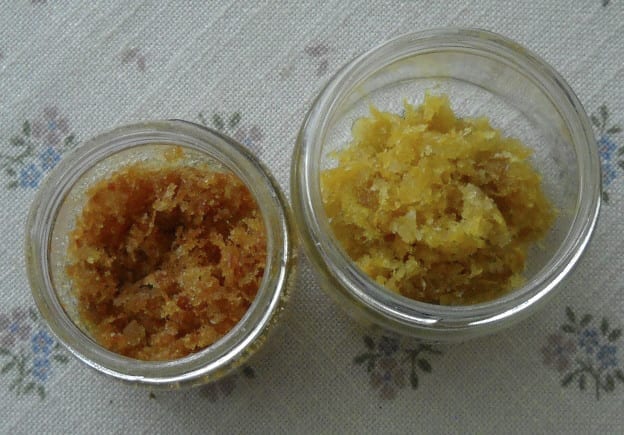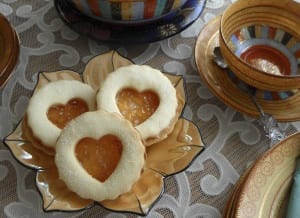 Yesterday I posted a cookie recipe that includes a dusting of sugar while the cookies are warm out of the oven.
Yesterday I posted a cookie recipe that includes a dusting of sugar while the cookies are warm out of the oven.
It got me thinking about flavoured (my Canadian is showing) sugars and that led on to a couple of additional points every magical pantry can benefit from.
First off, let’s chat about zesting. The zest is the coloured portion of the skin of oranges, limes, lemons and other citrus fruits. They add extra flavour to batters, dough and salad dressings, make nice toppings on muffins or desserts and can be easily preserved in sugar. I keep two bottles in the fridge, lemon and orange.
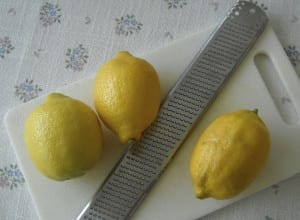 I think it was Martha Stewart who took carpentry tools in a new direction by using a wood workers planer as a grater. They do quick work of any citrus peel and give nice tiny evenly sized pieces.
I think it was Martha Stewart who took carpentry tools in a new direction by using a wood workers planer as a grater. They do quick work of any citrus peel and give nice tiny evenly sized pieces.
This one comes from a tool store and you can find them now with handles in cooking stores and online, search microplaner.
Before juicing the fruit, roll it back and forth under the palm of your hand several times to break down the cell membrane inside. Zest the peel before cutting in half and juicing. Zesting after juicing is not as easy.
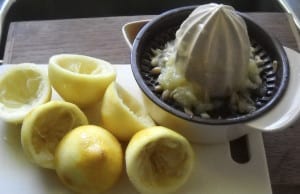 Use the juice for any recipe you would like or freeze it in a jar or an ice cube tray. Put the zested peel into a jar with some sugar and mix together.
Use the juice for any recipe you would like or freeze it in a jar or an ice cube tray. Put the zested peel into a jar with some sugar and mix together.
I add about 1 Tbsp. sugar per each lemon. This is not actually a flavoured sugar as much as it is preserved peel but a great way to add an extra layer of flavour to your preparations.
The peel will continue to release moisture so the finished product will get a little clumpy but will easily separate once added to any batter and mixed.
 Use small jars and refresh each time you use a fresh lemon, lime, orange or grapefruit. There is not need to have all four, just what you would like to use in your kitchen.
Use small jars and refresh each time you use a fresh lemon, lime, orange or grapefruit. There is not need to have all four, just what you would like to use in your kitchen.
Now on to the flavoured sugar part. Use a pint sized jar and fill it with sugar and the zest of one lemon. Put the top on and shake well to combine. Allow the bottle to sit for a week or two to infuse the sugar with lemony goodness.
This can be done with vanilla beans, lavender petals, violets. cinnamon sticks and a number of other spices.
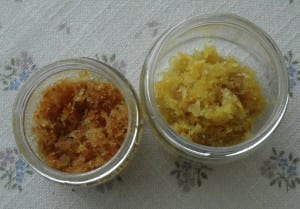 I have read several suggestions about scooping out the inside of the vanilla pod and adding it to the sugar, then sieving the sugar after a few weeks. I have been making vanilla sugar for decades ( it’s a German thing ) and I find that putting a couple of fresh uncut pods into a jar of sugar and letting it sit will be do the job just fine. Refill with sugar as needed, the pods will last a long time.
I have read several suggestions about scooping out the inside of the vanilla pod and adding it to the sugar, then sieving the sugar after a few weeks. I have been making vanilla sugar for decades ( it’s a German thing ) and I find that putting a couple of fresh uncut pods into a jar of sugar and letting it sit will be do the job just fine. Refill with sugar as needed, the pods will last a long time.
Flavoured sugars from things like raspberries take a little longer to make and the season is not here yet, so no pictures to share, sorry.
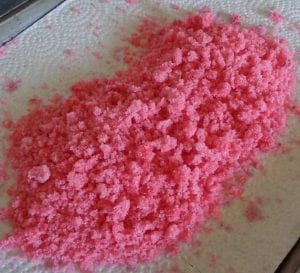 UPDATE: (Pictures!) Blend 2 – 4 raspberries into a puree and add to 1 cup of sugar. Mix well. It will be moist, pink and clumpy. Spread out over a pan and allow to dry in a safe place. I used a non heated oven and made double. It took 36 hours to dry out.
UPDATE: (Pictures!) Blend 2 – 4 raspberries into a puree and add to 1 cup of sugar. Mix well. It will be moist, pink and clumpy. Spread out over a pan and allow to dry in a safe place. I used a non heated oven and made double. It took 36 hours to dry out.
Once dry, get the clumps out with a spoon or hands. I found a sieve too time consuming and resorted to quick pulses in a blender. I found that brought out more moisture and it then needed to dry a little longer before bottling. (There will be more clumps to get rid of.)
Use on cookies, in iced tea or anything else you might sprinkle a teaspoon over.
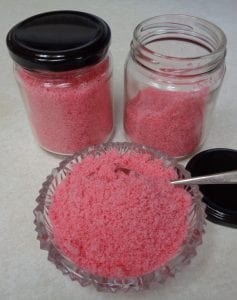 One thing to keep in mind is that when making herbed salts you start with courser salt and blend it down to regular size but course sugar in quantity is not always easy to find and you don’t want to make icing (confectionery) sugar, so do not blend too long.
One thing to keep in mind is that when making herbed salts you start with courser salt and blend it down to regular size but course sugar in quantity is not always easy to find and you don’t want to make icing (confectionery) sugar, so do not blend too long.
When deciding which flavoured sugars to have on hand think about taste, health properties and their magical aspects.
Orange, lemon and vanilla are available through out the year and can be made up at any time.
Raspberries on the other hand, not so much if you want to use fresh local berries, I made two cups to get me through the year.
Bon Appetite!

